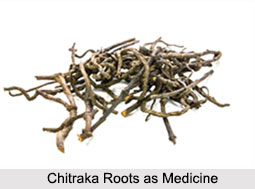 Chitraka is used in most of Ayurvedic medicines for indigestion. Its botanical name is Plumbago Zeylanica. It is a medicinal herb that is used in treatment of variety of diseases in Indian traditional system of medicine. The roots are purified as per Ayurvedic text before using medicinally. Another Ayurvedic name of this herb is "Agni", which means fire.
Chitraka is used in most of Ayurvedic medicines for indigestion. Its botanical name is Plumbago Zeylanica. It is a medicinal herb that is used in treatment of variety of diseases in Indian traditional system of medicine. The roots are purified as per Ayurvedic text before using medicinally. Another Ayurvedic name of this herb is "Agni", which means fire.
Health Benefits of Chitraka
The root of Plumbago Zeylanica is said to increase the digestive power, to promote the appetite and to be useful in dyspepsia, piles, anasarca, diarrhoea, skin diseases, etc. It is much used as a stimulant adjunct to other preparations, in the form of a combination called trimada consisting of plumbago root, baberang seeds and the tubers of Cyperus rotundus (mustaka).
Dose of Chitraka in Medicine
It enters into the composition of numerous medicines for dyspepsia. The illustration is to take plumbago root, rock salt, chebulic myrobalan and long pepper, equal parts; powder and mix. Dose is about 40 grains. A favourite medicine for flatulence is an old prescription of Sushruta called Shaddharana Yoga. It is a powder composed of equal parts of the following substances, namely, plumbago root, indrajava seeds, root of Stephania hernandifolia (patha), of Picrorrhiza Kurroa (katuki), atis and chebulic myrobalan. Dose should be about a drachm.
The root of Plumbago Zeylanica is said to exercise a beneficial effect on piles, in which disease it is given in various combinations. One mode of administering it is as follows; an earthen jar or pot is lined in its interior with a paste of the root, and curdled milk (dadhi) or Kanjika is prepared in this pot and taken by persons affected with haemorrhoids and prurigo.
Plumbago root reduced to a paste is applied to abscesses with the object of opening them. It enters also into the composition of several preparations used as caustics. The following is an illustration; take plumbago root, root of Baliospermum montanum (danti), the milky juice of Euphorbia nerii/olia (snuhi) and Calotropis procera or Hamiltonii (arka), marking nut, sulphate of iron, treacle and rock salt, equal parts; mix them together and make into a paste.
Related Articles
Ayurveda
Origin of Ayurveda
Ayurveda Medication
Elements of Ayurveda
Concepts of Ayurveda
Ancient Literature of Ayurveda
Properties of Material Objects and its Effect on Human Body





